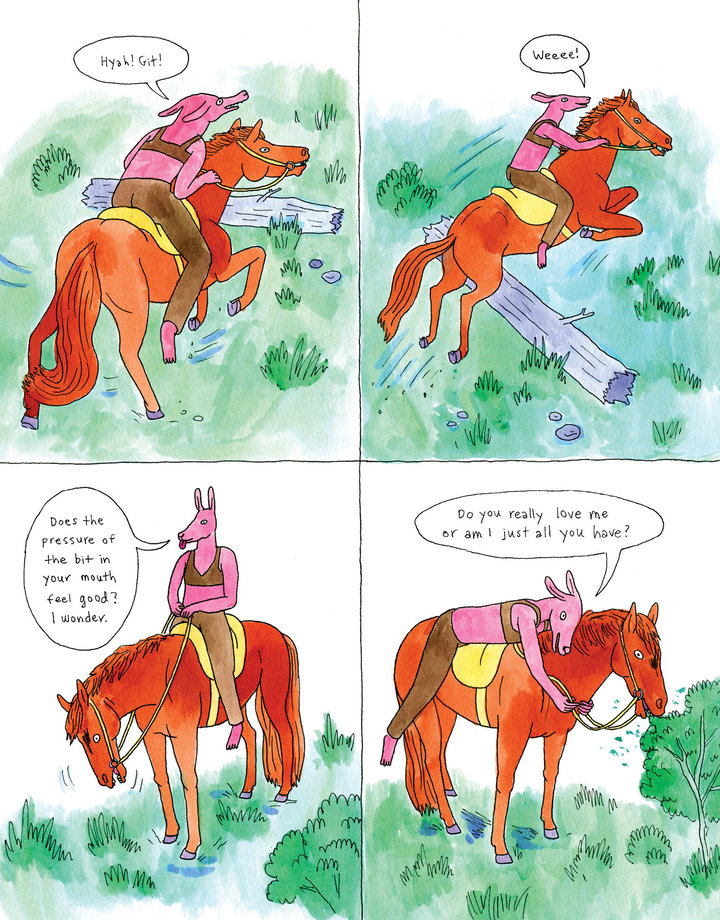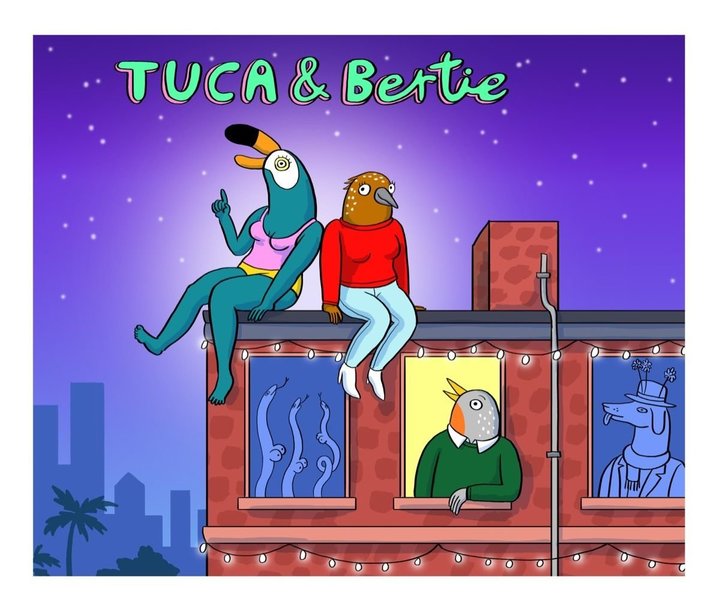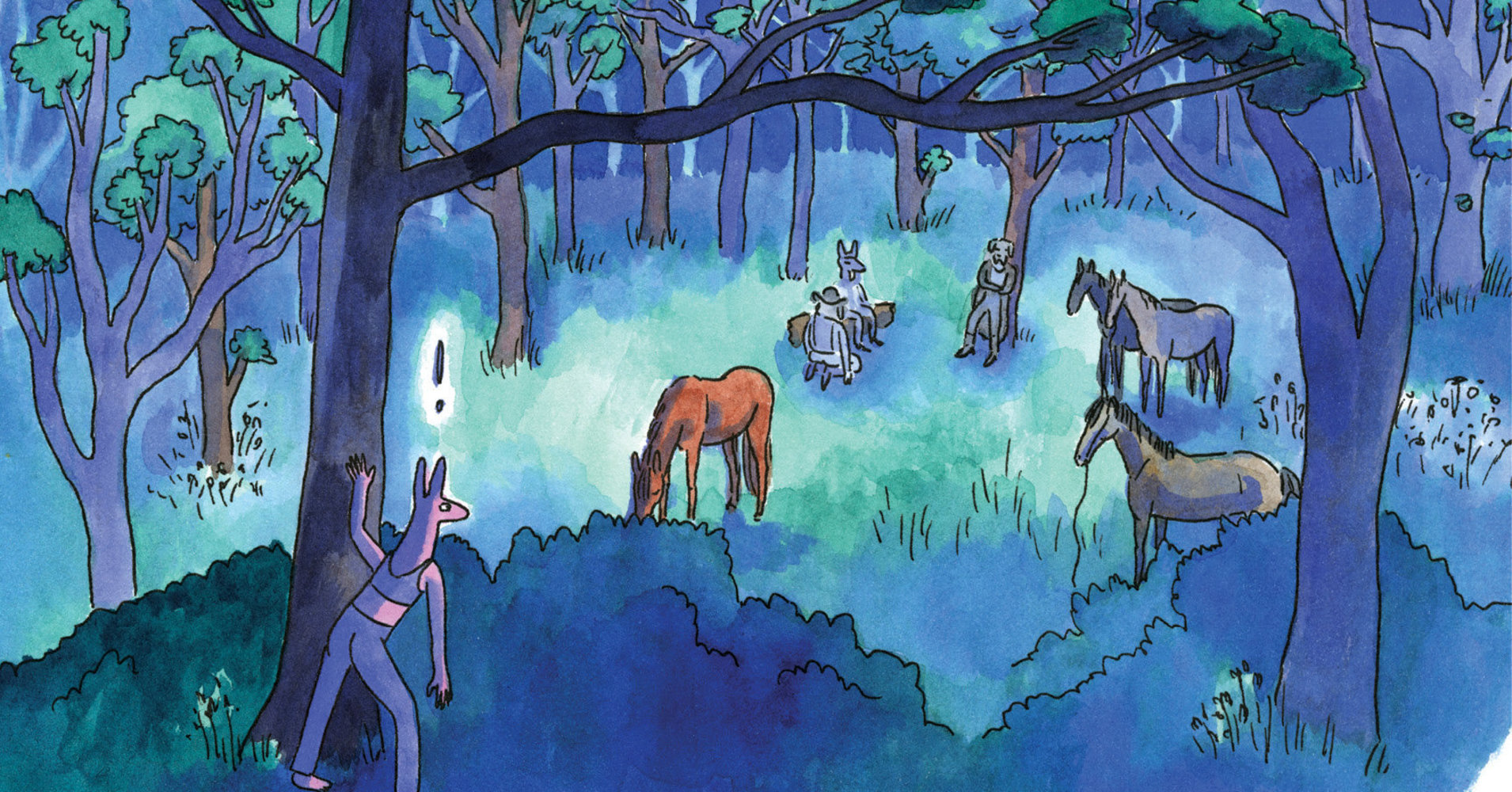[ad_1]
“To start off, I’ll make it clear that I like horses,” 11-year-old Lisa Hanawalt wrote on a sheet of loose-leaf paper beneath the heading “About Me” in 1994.
“I get that,” her teacher commented in the margins with thick, purple ink.
Lisa wasn’t finished. “I REALLY Like Horses,” she continued. “I Really REALLY like them! Everyone who knows me says it’s more than an obsession. They’re probably right. People make fun of me and call me ‘Horse Poop’ and ‘Lady Horse.’ I just take it as a compliment, or I figure that they must like Horse Poo a lot cause I hear them say it whenever I pass!”
“I’m also wild about art,” Hanawalt concluded. “I want to be famous for drawing horses someday.”
“What a wonderful goal!” the teacher scribbled.
Today, 35-year-old Hanawalt has fulfilled that unlikely and specific prophecy. The writer and artist is best known as the lead illustrator on “BoJack Horseman,” an animated Netflix show about a washed-up actor struggling with depression, addiction and fleeting fame in the wilds of Los Angeles. This BoJack is, as his surname suggests, a horse.
Hanawalt’s televised gem of horse-centric content shattered any assumptions that cartoons can’t make a grown woman cry ― and that stallions cannot rock aviator sunglasses. But it’s not her only contribution to the equestrian canon. This week, she released “Coyote Doggirl,” a graphic novel that puts the traditional Western epic through a fur-house mirror.
“I wanted to recreate a Western in my own voice, through my own eyes,” Hanawalt told HuffPost earlier this month. “To tell a story about female struggle and female pain from my own perspective.”
Compared to the cowboy tales of yore, Hanawalt’s point of view is less racist, less misogynist, more empathetic toward animals, warier of violence as a mode of problem-solving, and a lot pinker.
The story’s plucky heroine is a hot pink coyote-dog-girl hybrid with a great sense of fashion, a deranged sense of humor and a lone wolf mentality. She is a humanoid canine ― the kind who walks, talks and creates leather crop tops from scratch ― while her beloved horse Red has the communication abilities of, well, a straight-up horse.
“The dog characters are stand-ins for humans, so they talk and think like people,” Hanawalt explained. “The horses are just horses.”
On the open road, Doggirl engages her equestrian companion in one-sided conversations.
“Does the pressure of the bit in your mouth feel good?” Doggirl asks, her tongue flopped out of her mouth in excitement. “I wonder.”
In the next frame, she’s slumped atop her noble steed, asking, “Do you really love me or am I just all you have?”
The exchanges resemble the asymmetrical interrogations humans so often have with their pets. (Do you like me? Are you happy? What’s going on in there?!)
That’s the magic of Hanawalt’s anthropomorphized worlds: Their bonkers imagery and relatable banter ricochet off one another to yield an adult fantasyland at once chimerical and comfortable.

Drawn Quarterly
Doggirl’s relationship with Red echoes Hanawalt’s own experiences interacting with horses. “I think horses are magical and intuitive and amazing,” she said. “But at the same time, sometimes they’re just big, dumb animals.”
As much a tribute to Westerns like “Dances with Wolves” and “True Grit,” “Coyote Doggirl” is a love letter to horses of all breeds, colors and speaking capabilities. Hanawalt has felt an inexplicable love for the creatures since she started taking horseback riding lessons at 8 years old.
“I think, for little girls, it’s cool to have control over something,” she said. “Because young women don’t have control over so many aspects of their lives. Riding this big, powerful animal that actually listens to you and obeys you is very empowering and therapeutic.”
Doggirl’s undying love for her horse propels Hanawalt’s story from start to finish. That and her desire to outrun a gang of Very Bad Dogs desperate to roast Doggirl’s body over a spit. Yes, the story gets dark, but it’s also sprinkled with deadpan banter and sight gags that make the outlandish tale of a dog’s open-air expedition feel as relatable as a meme bound to elicit a resounding “it me.” Dirty wisecracks are tempered by rhapsodic, watercolor landscapes, catering to readers’ base desires and elevated tastes alike.
Hanawalt employs similar wizardry with “BoJack,” which brings to life an alternative Hollywood fantasy ― in which humans and humanoid animals exist in tandem ― with oddball visuals that embed pun-happy punchlines in every frame. Crocodiles wear Crocs, “Koalafornication” is a hit television show, FKA Pigs and Llama del Rey are pop sensations.
A newly released book titled BoJack Horseman: The Art Before the Horse dives into the history of the show’s visual universe, featuring relics from Hanawalt’s past, including her 11-year-old musings on horse art.
For most of us, growing up requires abandoning the assumption that age-appropriate art and literature will be peppered with humanoid, furry friends. Thankfully, Hanawalt hung on to her childhood instincts, and as a result, she’s injected her addictive brand of sassy animals into the lifeblood of contemporary pop culture.
“BoJack” uses the animal kingdom to highlight the folly of our human rituals ― everything from eating organic food to wearing pants looks sillier when executed by a beast. Yet the initial silliness often belies an emotional intensity bubbling beneath, causing the inevitable gutting punchlines and heart-rending codas to hit home extra hard.
Hanawalt and her colleagues’ uncanny abilities to bring such an absurd show to life is so convincing it prompted a March Reddit query, “Does anyone else think Princess Carolyn is hot?” (For the unfamiliar, Princess Carolyn is a cat, and yes.)
When I asked Hanawalt whether she imagines her real-life human companions as animals, she told me, “it’s very personal, and if you tell people they look like the wrong animal, they get very upset.” Instead, she asks friends which animal they imagine for themselves. For Hanawalt herself, the answer fluctuates constantly, from a freshly primped poodle to a scrawny eagle to a sassy toucan named Tuca.
“Tuca is a way of me getting to my id,” Hanawalt told HuffPost in 2016. The bird is prominently featured in her previous book “Hot Dog Taste Test.” “She often behaves the way I imagine myself behaving if I didn’t care — the selfish, bratty part of me.”
This lucky bird is about to get her onscreen debut in Hanawalt’s upcoming animated comedy “Tuca & Bertie” on Netflix, about a loudmouth toucan and nervous songbird voiced by comedians Tiffany Haddish and Ali Wong.

Netflix
Hanawalt recently wrapped up the writing process. She says the key was following her dreams. Literally.
“So many of the show’s storylines have come out of weird dreams I had,” she said. “Often, I’ll go to sleep thinking of a problem in the story and I’ll dream a solution. Half the time it doesn’t make sense at all, but surprisingly, often it works!”
Hanawalt often dreams about the talking animals that populate her notebooks and imagination. “I totally did have a sex dream about a character the other night and I was so ashamed!” she said. “Now I know I really have been working too hard.”
If only 11-year-old Lisa “Horse Poop” Hanawalt could hear those words. I think she’d be very proud. Maybe a little freaked out, but mostly proud.
[ad_2]
Source link

